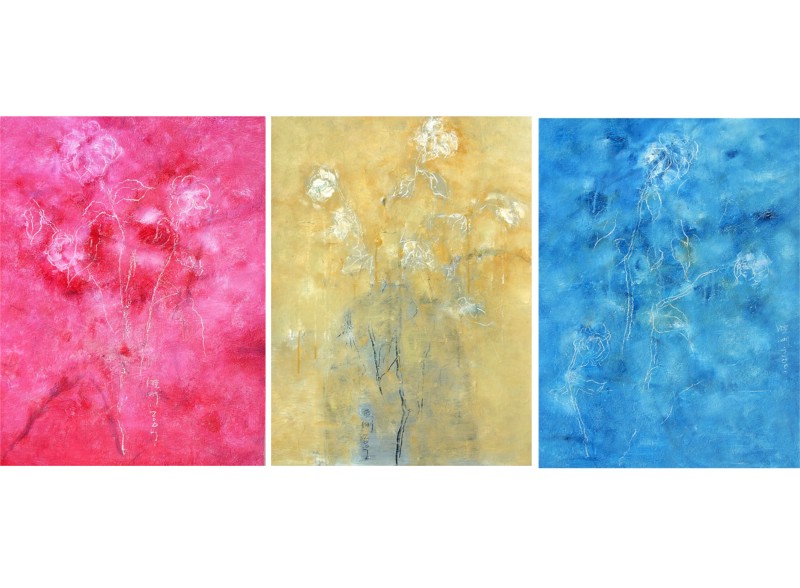|
I like Geng Xiao-gang’s recent oil paintings on paper. The sparse lotus of autumn, the flower arrangement in the vase, the winding mountain in distance, and the farmhouse in the mist of chimney smoke, are ubiquitously endowed with an impression of poetry. Lotus is his favorite. In reality, lotus vanishes as time goes by, making people often to emphasize with the eternality of time and uncertainty of life. Xiao-gang’s lotus, however, is rich in rhythms, and after a few random brushes, personated with strong characters, in which we could envision his peace of mind when painting. It’s fair enough to say that Xiao-geng’s mind runs as deep as still water. Easily comes to mind is the candidness and conciseness in his way of portraying an object. All objectives, under his brush, are revivified to basic outlines and shapes. Without drawings of shadows and lights on the surface, his depiction is reminiscent of those wayward strokes in traditional Chinese ink painting. The lines in dust color are cautious yet run free. Large blank space scattered with light dark colors looks thin and empty, nevertheless not any lacking of sophistication. I appreciate Xiao-gang’s capability in capturing the characters of objectives in a nearly divinely way, because I know painting of this pinnacle requires a strong traditional aesthetics sense. The phenomena of simplicity and profoundness that underlies in Xiao-gang’s painting, is forged by this traditional sense, the ability to adapt it to nowadays, and of course, his sentimental attachment towards the objects of portrait.
Furthermore, I like the pen draft that Xiao-gang improvises upon preparation for his oil painting. The positions of objectives are pinched down within several scratches, saturated by water, the characters of objectives are vividly presented. Beauty is not measured by size, but its delicacy; preciseness not only refers to the resemblance, but also the style. For this talent and amazing grace, Xiao-gang, in my bold guess, was perhaps a lady with such unrivaled sophistication in his previous life.
Getting used to those various art forms that are currently flourishing to mirror the modern life, we will rediscover the real reason for painting in the works of an artist such as Xiao-gang: to reach to beauty through heart.

TRANQUILITY ON PAPER
Under such visual circumstance of chaos, contradiction and noisy, it seems like a breeze spreading over my face at a summer day. The intimate quietness brought a certain joy to my inner heart, making me believe that something in life should not be abandoned; even though we have to bear some pressure or isolation from the reality temporarily, the eagerness from our heart can always be lighted up by our initial motive.
Geng Xiaogang left his hometown, Baotou of Inner Mongolia, for Beijing in early 1990’s, when he was less than 20 years old, staying in the artist village of Yuanmingyuan. Yuanmingyuan was a dream land for the artists in China. Very soon, the dream still remained, while the land was disappeared by force. Xiaogang had to go to Tianjing Fine Arts School after Yuanmingyuan was dismissed. Xiaogang went to a designing company as a designer for survival after he had left the school. Being a designer influences Xiaogang’s painting significantly; the form of his painting becomes more applicable for visual aesthetics, while the content more simple.
Returning to essence is just returning to destiny, just as Chinese is fond of Zen and Taoism. Oriental philosophy illustrates from nothing to everything, then from everything back to nothing. It would be possible for a heart to obtain comfort and peace after life encountered the perplexity. Xiaogang’s works, no matter oil painting, or water ink, tries to unfold his feeling of such circumstance. There is neither clumsy in content, nor complication on material; every work on the original paper, with some light brushes, pieces of withered leafs and faded branches, sparse lotus and remote hills, simply the perfect. His work not only delivers his aesthetics, but also his life attitude.
By Xueyi at Dashazi Art Center
2006-06-25
|

